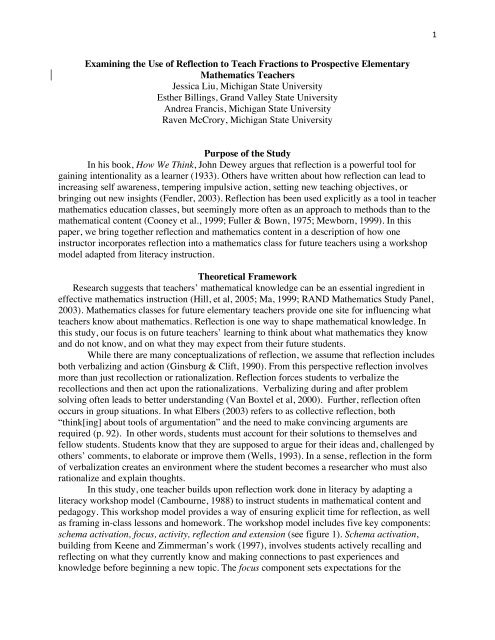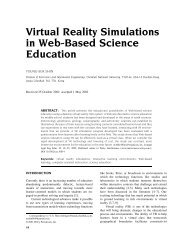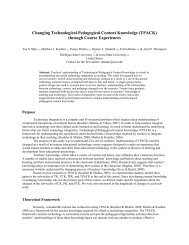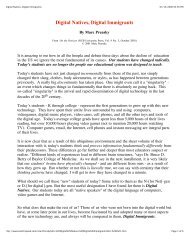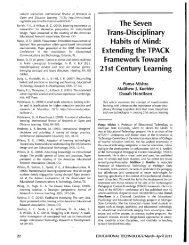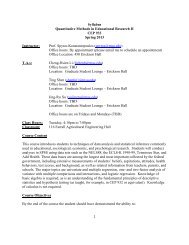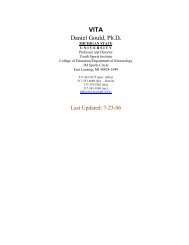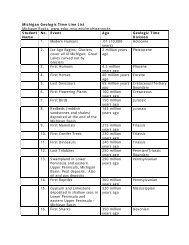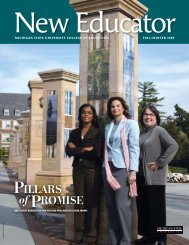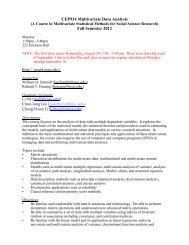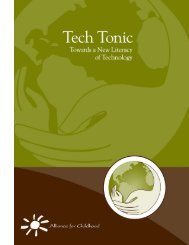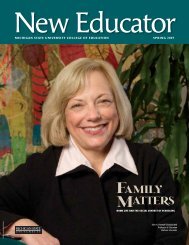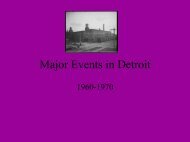Examining the Use of Reflection to Teach Fractions ... - ME.ET project
Examining the Use of Reflection to Teach Fractions ... - ME.ET project
Examining the Use of Reflection to Teach Fractions ... - ME.ET project
Create successful ePaper yourself
Turn your PDF publications into a flip-book with our unique Google optimized e-Paper software.
1 <br />
<strong>Examining</strong> <strong>the</strong> <strong>Use</strong> <strong>of</strong> <strong>Reflection</strong> <strong>to</strong> <strong>Teach</strong> <strong>Fractions</strong> <strong>to</strong> Prospective Elementary<br />
Ma<strong>the</strong>matics <strong>Teach</strong>ers<br />
Jessica Liu, Michigan State University<br />
Es<strong>the</strong>r Billings, Grand Valley State University<br />
Andrea Francis, Michigan State University<br />
Raven McCrory, Michigan State University<br />
Purpose <strong>of</strong> <strong>the</strong> Study<br />
In his book, How We Think, John Dewey argues that reflection is a powerful <strong>to</strong>ol for<br />
gaining intentionality as a learner (1933). O<strong>the</strong>rs have written about how reflection can lead <strong>to</strong><br />
increasing self awareness, tempering impulsive action, setting new teaching objectives, or<br />
bringing out new insights (Fendler, 2003). <strong>Reflection</strong> has been used explicitly as a <strong>to</strong>ol in teacher<br />
ma<strong>the</strong>matics education classes, but seemingly more <strong>of</strong>ten as an approach <strong>to</strong> methods than <strong>to</strong> <strong>the</strong><br />
ma<strong>the</strong>matical content (Cooney et al., 1999; Fuller & Bown, 1975; Mewborn, 1999). In this<br />
paper, we bring <strong>to</strong>ge<strong>the</strong>r reflection and ma<strong>the</strong>matics content in a description <strong>of</strong> how one<br />
instruc<strong>to</strong>r incorporates reflection in<strong>to</strong> a ma<strong>the</strong>matics class for future teachers using a workshop<br />
model adapted from literacy instruction.<br />
Theoretical Framework<br />
Research suggests that teachers’ ma<strong>the</strong>matical knowledge can be an essential ingredient in<br />
effective ma<strong>the</strong>matics instruction (Hill, et al, 2005; Ma, 1999; RAND Ma<strong>the</strong>matics Study Panel,<br />
2003). Ma<strong>the</strong>matics classes for future elementary teachers provide one site for influencing what<br />
teachers know about ma<strong>the</strong>matics. <strong>Reflection</strong> is one way <strong>to</strong> shape ma<strong>the</strong>matical knowledge. In<br />
this study, our focus is on future teachers’ learning <strong>to</strong> think about what ma<strong>the</strong>matics <strong>the</strong>y know<br />
and do not know, and on what <strong>the</strong>y may expect from <strong>the</strong>ir future students.<br />
While <strong>the</strong>re are many conceptualizations <strong>of</strong> reflection, we assume that reflection includes<br />
both verbalizing and action (Ginsburg & Clift, 1990). From this perspective reflection involves<br />
more than just recollection or rationalization. <strong>Reflection</strong> forces students <strong>to</strong> verbalize <strong>the</strong><br />
recollections and <strong>the</strong>n act upon <strong>the</strong> rationalizations. Verbalizing during and after problem<br />
solving <strong>of</strong>ten leads <strong>to</strong> better understanding (Van Boxtel et al, 2000). Fur<strong>the</strong>r, reflection <strong>of</strong>ten<br />
occurs in group situations. In what Elbers (2003) refers <strong>to</strong> as collective reflection, both<br />
“think[ing] about <strong>to</strong>ols <strong>of</strong> argumentation” and <strong>the</strong> need <strong>to</strong> make convincing arguments are<br />
required (p. 92). In o<strong>the</strong>r words, students must account for <strong>the</strong>ir solutions <strong>to</strong> <strong>the</strong>mselves and<br />
fellow students. Students know that <strong>the</strong>y are supposed <strong>to</strong> argue for <strong>the</strong>ir ideas and, challenged by<br />
o<strong>the</strong>rs’ comments, <strong>to</strong> elaborate or improve <strong>the</strong>m (Wells, 1993). In a sense, reflection in <strong>the</strong> form<br />
<strong>of</strong> verbalization creates an environment where <strong>the</strong> student becomes a researcher who must also<br />
rationalize and explain thoughts.<br />
In this study, one teacher builds upon reflection work done in literacy by adapting a<br />
literacy workshop model (Cambourne, 1988) <strong>to</strong> instruct students in ma<strong>the</strong>matical content and<br />
pedagogy. This workshop model provides a way <strong>of</strong> ensuring explicit time for reflection, as well<br />
as framing in-class lessons and homework. The workshop model includes five key components:<br />
schema activation, focus, activity, reflection and extension (see figure 1). Schema activation,<br />
building from Keene and Zimmerman’s work (1997), involves students actively recalling and<br />
reflecting on what <strong>the</strong>y currently know and making connections <strong>to</strong> past experiences and<br />
knowledge before beginning a new <strong>to</strong>pic. The focus component sets expectations for <strong>the</strong>
2 <br />
workshop; here students may be introduced <strong>to</strong> <strong>the</strong> <strong>the</strong>me <strong>of</strong> <strong>the</strong> lesson, a main question <strong>to</strong><br />
explore, a ma<strong>the</strong>matical strategy, children’s ma<strong>the</strong>matical thinking, or an article <strong>to</strong> read. The<br />
activity is <strong>the</strong> bulk <strong>of</strong> <strong>the</strong> workshop; students actively solve problems, collectively and<br />
individually exploring new ideas and connecting ideas. The teacher guides <strong>the</strong> students’<br />
problem-solving by asking questions and encouraging students <strong>to</strong> pose <strong>the</strong>ir own questions and<br />
construct new knowledge. Students may <strong>the</strong>n choose activities <strong>to</strong> continue <strong>the</strong>ir exploration <strong>of</strong><br />
<strong>the</strong> <strong>to</strong>pic. After completing activities, students engage in reflection on what <strong>the</strong>y have learned.<br />
Students collectively share <strong>the</strong>ir reflections, as well as individually record <strong>the</strong>m. Extensions are<br />
also provided, ei<strong>the</strong>r open ended or guided, giving students <strong>the</strong> opportunity <strong>to</strong> explore <strong>the</strong> <strong>to</strong>pic<br />
in more depth or from a different perspective. It is important <strong>to</strong> note that <strong>the</strong> different<br />
components <strong>of</strong> <strong>the</strong> workshop model are rarely entirely separate from each o<strong>the</strong>r. An activity<br />
could act as a way <strong>to</strong> activate schemas, reflect, or even extend knowledge. The model is more <strong>of</strong><br />
an explicit way <strong>of</strong> making sure that each <strong>of</strong> <strong>the</strong>se components is present when preparing and<br />
presenting <strong>the</strong> lessons.<br />
In <strong>the</strong> class described here, reflection realized through <strong>the</strong> workshop model was used <strong>to</strong><br />
increase prospective teachers’ ma<strong>the</strong>matical content knowledge, and understanding <strong>of</strong> future<br />
student thinking. This is different than <strong>the</strong> use <strong>of</strong> reflection about teaching practices because <strong>of</strong><br />
<strong>the</strong> focus on ma<strong>the</strong>matics: <strong>the</strong>re is correct ma<strong>the</strong>matics content <strong>to</strong> learn. One content area that<br />
prospective teachers have trouble with is fractions (Graeber et al, 1989; Harel et al., 1994; Simon<br />
& Blume, 1994). <strong>Fractions</strong> have been defined in myriad ways. We use Lamon’s (2007)<br />
suggestion that fractions are a subset <strong>of</strong> rational numbers, in that fractions are notational and are<br />
“non-negative rational numbers” (p. 635). A difficult <strong>to</strong>pic for students <strong>to</strong> understand is <strong>the</strong><br />
concept <strong>of</strong> <strong>the</strong> unit (eg., Isaak, 2008). Below we show how <strong>the</strong> instruc<strong>to</strong>r used reflection <strong>to</strong> help<br />
students learn about <strong>the</strong> concept <strong>of</strong> unit.<br />
Method <strong>of</strong> Inquiry and Data Sources: A Case <strong>of</strong> One <strong>Teach</strong>er Using <strong>Reflection</strong> in a<br />
Prospective Elementary <strong>Teach</strong>er Ma<strong>the</strong>matics Class<br />
As part <strong>of</strong> a larger study that explores <strong>the</strong> ma<strong>the</strong>matics content taught <strong>to</strong> undergraduate<br />
prospective elementary teachers, this paper focuses on one <strong>of</strong> seven instruc<strong>to</strong>rs videotaped<br />
teaching fraction lessons. Video was supplemented by field notes taken during instruction and an<br />
interview with <strong>the</strong> instruc<strong>to</strong>r. i We chose a single instruc<strong>to</strong>r for this paper because <strong>of</strong> her unique<br />
approach, using <strong>the</strong> workshop model, <strong>to</strong> help her students be reflective as <strong>the</strong>y learned<br />
ma<strong>the</strong>matics. Over 15 hours <strong>of</strong> video was ga<strong>the</strong>red for this instruc<strong>to</strong>r. Analysis <strong>of</strong> <strong>the</strong> video used<br />
an Iterative Refinement Cycle (Lesh & Lehrer, 2000) model with multiple interpretive cycles.<br />
The first cycle identified when and where <strong>the</strong> instruc<strong>to</strong>r explicitly explained reflective techniques<br />
for <strong>the</strong> students. The second cycle identified when <strong>the</strong> instruc<strong>to</strong>r explicitly used reflective<br />
techniques with her students. The third cycle was used <strong>to</strong> identify where <strong>the</strong> techniques were<br />
used implicitly in <strong>the</strong> classroom. The fourth cycle identified places where students were<br />
encouraged <strong>to</strong> use reflection when instructing <strong>the</strong>ir own students. Finally, throughout <strong>the</strong> entire<br />
process, o<strong>the</strong>r data sources, (field notes and interview) were used as supplements.<br />
Below we provide excerpts <strong>of</strong> <strong>the</strong> interpretive narrative and discuss how Edie (a pseudonym),<br />
a ma<strong>the</strong>matics pr<strong>of</strong>essor teaching prospective elementary school teachers, used reflective<br />
techniques <strong>to</strong> teach about fractions.<br />
Results
3 <br />
Edie teaches a combined methods and content class at a public university. The class is<br />
designed <strong>to</strong> explore <strong>the</strong> teaching and learning <strong>of</strong> number and operations (whole numbers,<br />
fractions, decimals, and number <strong>the</strong>ory) in elementary school ma<strong>the</strong>matics emphasizing <strong>the</strong><br />
development <strong>of</strong> number sense and unitizing. Fieldwork for this course includes evaluating and<br />
tu<strong>to</strong>ring elementary children. There were 11 students in <strong>the</strong> class, nine <strong>of</strong> whom were female.<br />
Students sat in assigned groups at three tables.<br />
In this section <strong>of</strong> <strong>the</strong> paper we discuss how Edie used reflection as an instructional <strong>to</strong>ol<br />
in <strong>the</strong> schema activation portion <strong>of</strong> <strong>the</strong> workshop model. In <strong>the</strong> full paper we will describe how<br />
reflection was used in <strong>the</strong> o<strong>the</strong>r elements <strong>of</strong> <strong>the</strong> workshop.<br />
Edie began <strong>the</strong> fraction workshop by figuring out what students thought <strong>the</strong>y knew about<br />
fractions. Edie helped <strong>the</strong> students activate <strong>the</strong>ir schema <strong>of</strong> fractions by asking <strong>the</strong> groups <strong>to</strong><br />
develop a collective list <strong>of</strong> things <strong>the</strong>y knew about fractions. In <strong>the</strong> groups, students were able <strong>to</strong><br />
verbalize <strong>the</strong>ir understanding <strong>of</strong> fractions. One issue that <strong>the</strong> groups brought up during <strong>the</strong>ir<br />
collective reflection was how <strong>to</strong> represent <strong>the</strong> fraction. Many <strong>of</strong> <strong>the</strong> groups talked about using<br />
circles <strong>to</strong> represent fractions, but that <strong>the</strong>re might be o<strong>the</strong>r ways <strong>to</strong> do it. By activating schemas,<br />
students personally saw <strong>the</strong>ir lack <strong>of</strong> knowledge about how <strong>to</strong> represent fractions and <strong>the</strong> need <strong>to</strong><br />
learn more about representing fractions. The action that was needed was <strong>to</strong> <strong>the</strong>n learn more about<br />
representing fractions.<br />
Based on Edie’s prior knowledge <strong>of</strong> previous years’ students’ lack <strong>of</strong> understanding<br />
about representing fractions and <strong>to</strong> fur<strong>the</strong>r build upon <strong>the</strong>ir fractions schema, Edie had <strong>the</strong><br />
prospective teachers solve <strong>the</strong> following problem from a grades 4-6 module on fractions.<br />
Sub Problem: A class goes on a field trip. The first group has 4 people, and <strong>the</strong>y get<br />
three sub sandwiches <strong>to</strong> share. The second group has 5 people and gets 4 subs. The third<br />
group has 8 people and gets 7 subs. The last group has 5 people and gets 3 subs. Which<br />
group gets <strong>the</strong> most food per person? (Fosnot, 2007)<br />
By having her students solve a problem, Edie provided a context for identifying<br />
additional types <strong>of</strong> understanding that her students could not verbalize when simply asked about<br />
what <strong>the</strong>y knew about fractions. While <strong>the</strong> problem solving is part <strong>of</strong> <strong>the</strong> activity portion <strong>of</strong> <strong>the</strong><br />
workshop, it also forces <strong>the</strong> students <strong>to</strong> reflect and activate <strong>the</strong>ir fraction schema as <strong>the</strong>y must<br />
verbalize what <strong>the</strong>y know about representing and comparing fractions in order <strong>to</strong> solve <strong>the</strong><br />
problem.<br />
To get <strong>the</strong> students <strong>to</strong> make explicit how <strong>the</strong>y solved <strong>the</strong> problem, Edie first had each <strong>of</strong><br />
<strong>the</strong> groups create a poster <strong>to</strong> represent each <strong>of</strong> <strong>the</strong> situations. Edie asked <strong>the</strong> students <strong>to</strong> draw it<br />
in such a way that <strong>the</strong>ir own future students would be able <strong>to</strong> understand how <strong>to</strong> compare<br />
fractions. In <strong>the</strong> next class period, Edie had students discuss <strong>the</strong> posters <strong>the</strong>y made <strong>to</strong> represent<br />
<strong>the</strong> submarine problem. Edie asked, “What kind <strong>of</strong> strategy and representation did your<br />
classmates make in order <strong>to</strong> answer this question?” and “what is <strong>the</strong> underlying meaning <strong>of</strong> <strong>the</strong><br />
fraction?”<br />
The activity, <strong>the</strong> action <strong>of</strong> presenting <strong>the</strong> problem <strong>to</strong> each o<strong>the</strong>r, was explicitly designed<br />
<strong>to</strong> have students recall and rationalize what <strong>the</strong>y did in <strong>the</strong> previous class period so that Edie<br />
could fur<strong>the</strong>r build upon that existing knowledge. In this way, <strong>the</strong> activity was also an example<br />
<strong>of</strong> schema activation. Through a whole class discussion <strong>of</strong> each group’s posters, <strong>the</strong> students<br />
engaged in collective reflection by sharing and analyzing each o<strong>the</strong>r’s solutions and identifying<br />
what <strong>the</strong>y did not understand about fraction representation. For example, <strong>to</strong> figure out how much<br />
<strong>the</strong> first group in <strong>the</strong> submarine problem gets, one <strong>of</strong> <strong>the</strong> groups represented <strong>the</strong> problem by<br />
putting <strong>the</strong> three subs <strong>to</strong>ge<strong>the</strong>r in<strong>to</strong> one large rectangle, divided each sub in<strong>to</strong> 4, and said that
4 <br />
each person got 3/12 <strong>of</strong> a sub, which was an incorrect answer (Figure 2). After Edie asked <strong>the</strong><br />
group how <strong>the</strong>y got 3/12 <strong>of</strong> a sub, <strong>the</strong> group explained <strong>the</strong>ir representation in a way that<br />
suggested <strong>the</strong>y got ¾ <strong>of</strong> sub (<strong>the</strong> correct answer). One <strong>of</strong> <strong>the</strong> students in <strong>the</strong> group responded, “I<br />
don’t know what I did [<strong>the</strong> first time].” The class discussion had influenced <strong>the</strong> way this student<br />
solved <strong>the</strong> problem. She had listened <strong>to</strong> and unders<strong>to</strong>od <strong>the</strong> o<strong>the</strong>r groups’ explanations and used<br />
<strong>the</strong>m <strong>to</strong> correct her own representation. However, <strong>the</strong> student realized she could not argue for<br />
how <strong>the</strong> problem was originally solved because she did not understand where she made a<br />
mistake in her own reasoning; she did not comprehend <strong>the</strong> importance <strong>of</strong> a fractional unit<br />
Ultimately, <strong>the</strong> vocalization <strong>of</strong> how <strong>the</strong>y solved <strong>the</strong> problem – activating <strong>the</strong>ir schema <strong>of</strong><br />
fractions -- allowed <strong>the</strong> students <strong>to</strong> see that <strong>the</strong>y had made a mistake about <strong>the</strong> unit and whole<br />
(one sub versus three subs) involved in solving <strong>the</strong> problem. Fur<strong>the</strong>r, <strong>the</strong> students actually<br />
figured out what <strong>the</strong> correct answer was <strong>to</strong> <strong>the</strong> problem (3/4) (see <strong>the</strong> dialogue in figure 3 for <strong>the</strong><br />
complete transcription <strong>of</strong> this part <strong>of</strong> <strong>the</strong> lesson).<br />
Significance <strong>of</strong> <strong>the</strong> Study<br />
In this paper we have shown how one instruc<strong>to</strong>r used <strong>the</strong> instructional <strong>to</strong>ol <strong>of</strong> reflection,<br />
made more explicit in <strong>the</strong> workshop model, <strong>to</strong> help students understand what <strong>the</strong>y do and do not<br />
understand about units in fractions. To our knowledge this is <strong>the</strong> first time <strong>the</strong> workshop model,<br />
modified from instructional approaches in literacy, has been explicitly used in a ma<strong>the</strong>matics<br />
class for prospective elementary teachers. Fur<strong>the</strong>r, this is an example <strong>of</strong> <strong>the</strong> use <strong>of</strong> reflection as<br />
an instructional <strong>to</strong>ol <strong>to</strong> teach students <strong>to</strong> figure out what ma<strong>the</strong>matics content <strong>the</strong>y do not fully<br />
unders<strong>to</strong>od. We ultimately hope that this approach will encourage prospective teachers <strong>to</strong> take<br />
responsibility for <strong>the</strong>ir own learning by reflecting on what <strong>the</strong>y do and do not know about<br />
ma<strong>the</strong>matics <strong>to</strong>pics.<br />
References<br />
Cambourne, B. (1988). The Whole S<strong>to</strong>ry: Natural learning and <strong>the</strong> acquisition <strong>of</strong> literacy.<br />
Auckland, New Zealand, Ash<strong>to</strong>n Scholastic.<br />
Cooney, T., Shealy, B., & Arnold, B. (1998). Conceptualizing belief structures <strong>of</strong> preservice<br />
secondary ma<strong>the</strong>matics teachers. Journal <strong>of</strong> Research in Ma<strong>the</strong>matics Education, 29(3),<br />
306-333.<br />
Dewey, J. (1933). How we think: A restatement <strong>of</strong> <strong>the</strong> relation <strong>of</strong> reflective thinking <strong>to</strong> <strong>the</strong><br />
educative process. Bos<strong>to</strong>n: Heath.<br />
Elbers, E. (2003). Classroom interaction as reflection: Learning and <strong>Teach</strong>ing Ma<strong>the</strong>matics in a<br />
Community <strong>of</strong> Inquiry. Educational Studies in Ma<strong>the</strong>matics (p.77-99). Ne<strong>the</strong>rlands:<br />
Kluwer Academic Publishers.<br />
Fendler, L. (2003). <strong>Teach</strong>er <strong>Reflection</strong> in a Hall <strong>of</strong> Mirrors: His<strong>to</strong>rical Influences and Political<br />
Reverberations. Educational Researcher (p.16-25).<br />
Fosnot, C. T. (2007). Day One: The Field Trip (pp. 13-18). Contexts for Learning Ma<strong>the</strong>matics<br />
Grades 4-6”: Field Trips and Fund-Raisers: Introducing <strong>Fractions</strong>. Portsmouth, NH:<br />
Firsthand Heinemann.<br />
Fuller, F. F., & Bown, O. H. (1975). Becoming a teacher. In K. Ryan (Ed.), <strong>Teach</strong>er education:<br />
Seventy-fourth yearbook <strong>of</strong> <strong>the</strong> National Society for <strong>the</strong> Study <strong>of</strong> Education, (Part II, pp.<br />
25-52). Chicago: National Society for <strong>the</strong> Study <strong>of</strong> Education.
5 <br />
Ginsburg, M. B., & Clift, R. T. (1990). The hidden curriculum <strong>of</strong> preservice teacher education.In<br />
W. R. Hous<strong>to</strong>n Macmillan. (Ed.), Handbook <strong>of</strong> research on teacher education (p. 450-<br />
465). New York: Macmillan.<br />
Graeber, A., Tirosh, D., & Glover, R. (1989). Preservice teachers’ misconceptions in<br />
sovivng verbal problems in multiplication and division. Journal for Research in<br />
Ma<strong>the</strong>matics Education, 20(1), 95-102.<br />
Harel, G, Behr, M., Post, L., & Lesh, R. (1994). The impact <strong>of</strong> number type on <strong>the</strong> s<br />
solution <strong>of</strong> multiplication and division problems. In G. Harel & J. Confrey (Eds.), The<br />
development <strong>of</strong> multiplicative reasoning in <strong>the</strong> learning <strong>of</strong> ma<strong>the</strong>matics (pp. 363-384).<br />
New York: State University <strong>of</strong> New York Press.<br />
Hill, H. C., Rowan, B., & Ball, D. L. (2005). Effects <strong>of</strong> teachers' ma<strong>the</strong>matical knowledge for<br />
teaching on student achievement. American Educational Research Journal, 42(2), 371-<br />
406.<br />
Izsak, A. (2008). Ma<strong>the</strong>matical knowledge for fraction multiplication. Cognition and Instruction,<br />
26, 95-143.<br />
Keene, E.O., Zimmerman, S. Mosaic <strong>of</strong> Thought: <strong>Teach</strong>ing Comprehension in a Reader's<br />
Workshop. Portsmouth: Heinemann. 1997.<br />
Lamon, S. J. (2007). Rational numbers and proportional reasoning: Toward a <strong>the</strong>oretical<br />
framework for research. In Handbook <strong>of</strong> Research on Ma<strong>the</strong>matics Education (pp. 629-<br />
667).<br />
Lesh, R., & Lehrer, R. (2000). Iterative refinement cycles for videotape analysis <strong>of</strong> conceptual<br />
change. In A. E. Kelly & R. A. Lesh (Eds.), Handbook <strong>of</strong> research design in ma<strong>the</strong>matics<br />
and science education (pp. 992). Mahwah, NJ: Lawrence Erlbaum Associates.<br />
Ma, L. (1999). Knowing and teaching elementary ma<strong>the</strong>matics. <strong>Teach</strong>ers’ understanding <strong>of</strong><br />
fundamental ma<strong>the</strong>matics in China and <strong>the</strong> United States. Mahwah, NJ: Erlbaum.<br />
Mewborn, D. S. (1999). Reflective thinking among preservice elementary ma<strong>the</strong>matics tachers.<br />
Journal for Research in Ma<strong>the</strong>matics Education, 30(3), 316-341.<br />
National Council <strong>of</strong> <strong>Teach</strong>ers <strong>of</strong> Ma<strong>the</strong>matics (NCTM) (2000). Principles and Standards <strong>of</strong><br />
School Ma<strong>the</strong>matics. Res<strong>to</strong>n, VA: NCTM.<br />
RAND Ma<strong>the</strong>matics Study Panel (2003). Ma<strong>the</strong>matical pr<strong>of</strong>iciency for all students: Towards a<br />
strategic development program in ma<strong>the</strong>matics education. Santa Monica, CA: RAND<br />
Corporation MR-1643-OERI.<br />
Simon, M.A., & Blume, G.W. (1994). Building and understanding multiplicative<br />
relationships: A study <strong>of</strong> prospective elementary teachers. Journal for Research in<br />
Ma<strong>the</strong>matics Education, 25(5), 472-494.<br />
Van Boxtel, C., Van der Linden, J., & and Kanselaar, G. (2000). Collaborative Learning Tasks<br />
and <strong>the</strong> Elaboration <strong>of</strong> Conceptual Knowledge.<br />
Wells, G. (1993)Reevaluating <strong>the</strong> IRF sequence: A proposal for <strong>the</strong> articulation <strong>of</strong> <strong>the</strong>ories <strong>of</strong><br />
activity and discourse for <strong>the</strong> analysis <strong>of</strong> teaching and learning in <strong>the</strong> classroom.<br />
Linguistics and Education, 5, 1-37.
6 <br />
Figure 1: Adapted Workshop Model from Cambourne (1988)<br />
<br />
Schema Activation <br />
Focus <br />
Activities: <br />
Compulsory <br />
& Choice <br />
<strong>Reflection</strong>
7 <br />
Figure 2: Group three’s use <strong>of</strong> an array <strong>to</strong> represent sandwiches and people<br />
8 <br />
<br />
<br />
Figure 3: Dialogue <strong>of</strong> students overcoming an incorrect answer <br />
Edie: now, what your group did … [draws a big square] what does this big rectangle represent? <br />
Student 1: well, we divided it up in<strong>to</strong> sub‐squares, <strong>the</strong>n… <br />
Edie: [divides square in<strong>to</strong> 3 rectangles] so here are your three subs, okay, [labels 1,2,3 vertically. <br />
Student 1: and you have <strong>to</strong> divide that [<strong>the</strong> <strong>to</strong>p side] by 4. So in <strong>the</strong> first column, you have ¼ <br />
Edie: one fourth <strong>of</strong> what? <br />
Student 1: <strong>of</strong> a sub <br />
Edie: so you’ve got ¼ <strong>of</strong> a sub [shades ¼], ano<strong>the</strong>r fourth <strong>of</strong> a sub [shades fourth], ano<strong>the</strong>r <br />
fourth <strong>of</strong> a sub [shades fourth]. So how do you know that’s three fourths? <br />
Student 2: we added <strong>the</strong>m up. <br />
Edie: at one point, you said <strong>the</strong>re were 3/12s sub. Now, did each person get 3/12 <strong>of</strong> a sub? <br />
Student 1: I don’t know what we did. <br />
Student 3 : all <strong>the</strong> subs <strong>to</strong>ge<strong>the</strong>r. <br />
Edie: all <strong>the</strong> subs <strong>to</strong>ge<strong>the</strong>r. If we had divided our 3 subs, right, in<strong>to</strong> 4 pieces, right? We’ve got 12 <br />
parts, right? Three <strong>of</strong> <strong>the</strong> parts. So we’ve got 3/12 <strong>of</strong> a sub or 3/12 <strong>of</strong> what? <br />
Student 4: 3 subs <br />
Edie: [nods] 3/12, right, <strong>of</strong> 3 subs. Now, 3/12s <strong>of</strong> 3 subs, what – do you know what fraction that <br />
is? <br />
Students: ¼ <br />
<br />
i For additional information see [authors, 2008]; Web site http://meet.educ.msu.edu/


